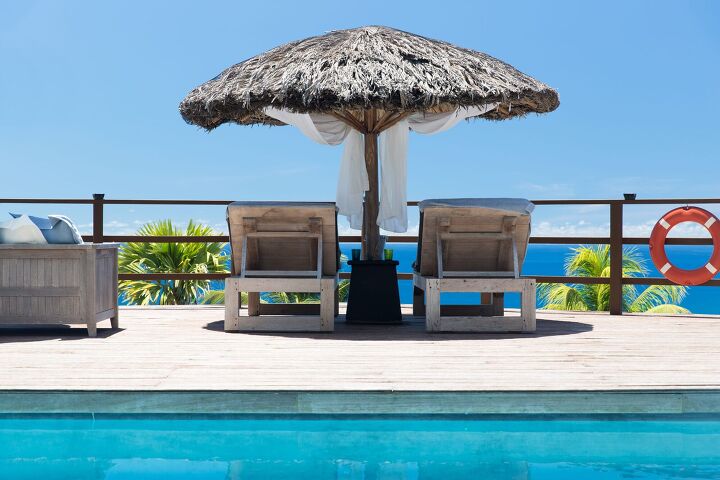How To Build A Palapa That Will Last

Adding a palapa to your patio or backyard setup is a fantastic and often affordable way to add tropical ambiance to your space. Palapas originated in Mexico, but you can now find them at nearly every tiki bar, resort pool, and beach bar all over the globe. Building a palapa yourself is certainly possible, and the materials are relatively affordable. But when you build one, you should follow several steps to ensure you build a palapa that will last a long time.
In order to build a palapa that will last, you need to purchase quality materials. Make sure everything from the frame to the thatching and rope you use to weave are high quality and weather-resistant. Make the right building and purchasing decisions for your specific climate. Regular upkeep and preventative maintenance go a long way to ensure the longevity of your palapa.
If you are preparing to build a palapa, or are curious how long a palapa would last in your pool area, keep reading. Just like with many outdoor structures, there are factors and variables to consider before you can accurately determine the lifespan of a palapa. First, you should know how long a typical palapa lasts, and then learn about the factors that can extend or shorten that lifespan.
How Long Does A Typical Palapa Roof Last?
No palapa lifespan is guaranteed with certainty. All it takes is one terrible tropical storm and your thatched roof is almost ensured to be partially or completely destroyed. Still, there are some averages to help you understand how long your palapa building investment will last.
On average, a Mexican palm-style palapa thatch roof lasts about 5 years. It may last as few as 2 years or upwards of 20 years. There are several elements, which are listed in this article, that affect the lifespan of the thatch roof. But as a rule of thumb, plan to budget for new thatching, or at least some significant roofing repair work, every 5 years or so.
The main structure of the palapa, if built with solid and weather-resistant materials, can last for generations.
Key Elements To Building A Palapa That Will Last
Purchase Quality Materials
Arguably the most important factor to consider when constructing a palapa that is built to last is the materials themselves. Palapas might have a shabby and shack-like appearance, but that doesn’t mean they are thrown together with scraps.
Don’t use any random type of thatch or palm fronds to cover the roof. For best results, you should use properly cut and dried Royal Palm leaves. These leaves are durable, waterproof, and insulating. They are considered the standard when building palm roofs. If you don’t have access to this type of palm leaf, ask an expert to direct you toward your local equivalent. Otherwise, with many types of palm trees out there, you may select a palm that decomposes easily or is susceptible to rot and disease.
Understand The Environmental Hazards
When you prepare to build your palapa, you must understand your climate and how it might affect an outdoor palapa. If you live somewhere with lots of wind, you need to ensure your thatch is thick, sturdy, and very tightly secured. If you live in a very wet climate, you must ensure you use materials that are very rot-resistant.
Not all palapas are built along a warm pleasant beach. Understanding how your weather interacts with natural materials and even metals, will help you build a long-lasting palapa.
Anticipate Problems
In addition to the climate, you should also anticipate other potential problems. If you build a palapa under a tree, consider trimming this tree. Tree matter decomposing on top of the thatch roof will only decrease its lifespan. If your area is known for certain pests or even nesting birds, prepare your palapa to resist these pests.
Four Key Steps To Building A Long-Lasting Palapa
1. Properly Prepare The Base Beneath The Structure
A lot of energy and thought is given to the thatch of a palapa. It is a major variable when it comes to longevity, and it also is the structure’s major decorative element. But you need to pay just as much attention (or more) to the base of the structure, and the ground beneath it.
Pick the right spot for your palapa. You want to choose somewhere stable, ideally at a higher elevation point in the yard. Do not put the structure along a flood zone as this will affect the integrity of the foundation.
When preparing the base of the structure, it is best to dig several feet deep and reinforce the palapa base with cement. This is particularly important in windy climates.
2. Construct A Sound Frame
Once the posts are secure, the next step is to build a stable and lasting frame. There are various methods you can employ to build a lasting frame. Palapas tend to have four corners, and the roof meets at a high point at the central beam.
All four corners and the central beam should be rooted. Then you should take steps to stabilize a square or rounded roof structure to these posts. Using plywood, or other strong woods to connect these beams works well. Rope as well as metal hardware works to connect the roof structure to the beams. This lays a strong foundation for the thatch.
Remember, the more structurally sound the palapa is, the less it will wiggle and move. A stationary palapa is less likely to break down and deteriorate prematurely.
3. Tightly Thatch The Roof From Bottom Up
The next step is to tightly and patiently install the thatch. At this point, unless you have installed a thatch roof yourself in the past, you may want to enlist a bit of help. Tightly weaving and installing a thatch roof is an art form, and sloppy thatch work will result in a sagging roof that will not stand the test of time.
As a general rule, thatching begins at the bottom of the structure and works its way to the top. This helps make the roof waterproof as well as better insulating. It also improves the aesthetics, making the roof look uniform and well-designed. Make sure the materials are tightly woven and tied, as this will help ensure a strong and long-lasting palapa.
4. Cover The Rooftop With Quality Decorative Fronds
The top layer of the roof should be both appealing to the eye as well as strong. Make sure all the areas that are directly exposed to the elements are strong. The materials purchased should be top quality, and woven tightly to avoid loosening and damage.
Tips And Tricks To Extend The Lifespan Of Your Palapa
Perform Regular Preventative Maintenance
Regardless of the materials you use and where you live, the best way to increase the lifespan of your palapa is to properly repair and maintain it regularly.
You should tighten and clean your palapa thatch roof at least once a year. The best way to do this is to set a schedule. Consider cleaning it each spring (or the start of the dry season) and then tighten it before the cold or windy season. This will keep the roof in top condition and less susceptible to vulnerabilities.
Remove Mold, Algae, And Rot As Soon As You Notice It
Another key to building a palapa that will last is keeping an eye on it after it is built Regardless of how well you built your structure, certain harmful elements can introduce themselves to the palapa.
These structures involve lots of organic materials, which means they are often susceptible to rot, algae, and mold. Regularly inspecting the thatch and beams for these issues is key. If you notice any of them, remove them. If left untreated, mold, algae, and rot will spread and destroy your palapa.
Avoid Corrosive And Rot-Prone Materials
In addition to maintaining your structure, try to think ahead and prevent these issues from occurring. If you live in a wet climate, it is important to choose materials that are less likely to attract mold and rot. Water-resistant thatch and beams are critical. Similarly, if you live in a salty climate, ensure any metal you use is resistant to corrosion.
Final Thoughts On Building A Palapa That Will Last
Building a palapa is a great way to bring paradise to your backyard. It can turn a fairly mundane outdoor setup into a tropical oasis. But any time you build an expensive and permanent structure, you want to make sure it will last a long time. In order to build a palapa that will last, consider your climate and purchase materials that can withstand the climate.
It is important you build the structure on solid ground, ideally at a higher elevation, and definitely not in an area that is susceptible to flooding. Ensure you perform regular maintenance on the structure, and eliminate mold or rot as soon as you notice it.
Related Guides:

Tom Gaffey is an expert writer who currently resides in Washington D.C. Tom has a passion for real estate and home improvement writing, as well as travel and lifestyle writing. He lived the last twelve years in Hawaii where he worked closely with luxury resorts and event planners, mastering his knowledge of aesthetics and luxury products. This is where he found his passion for home improvement and a keen interest in DIY projects. Currently, Tom resides in Washington D.C, and also working on his debut fiction novel.
More by Tom Gaffey










![The 10 Best Table Saws - [2022 Reviews & Buyer's Guide]](https://cdn-fastly.upgradedhome.com/media/2023/07/31/9070645/the-10-best-table-saws-2022-reviews-buyer-s-guide.jpg?size=350x220)


![Finishing Basement Without Permit [Is It Really Illegal?]](https://cdn-fastly.upgradedhome.com/media/2023/07/31/9070078/finishing-basement-without-permit-is-it-really-illegal.jpg?size=350x220)
![10 Best Electric Lawn Mowers - [2022 Reviews & Top Rated Models]](https://cdn-fastly.upgradedhome.com/media/2023/07/31/9070486/10-best-electric-lawn-mowers-2022-reviews-top-rated-models.jpg?size=350x220)












